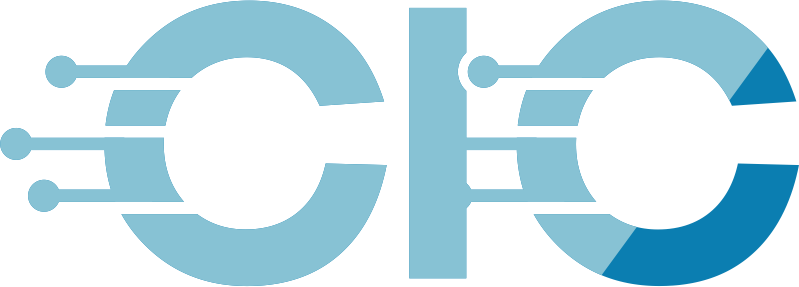Nordic Semiconductor acquires Memfault

Nordic Semiconductor announces the acquisition of its long-term partner, Memfault Inc., the market-leading cloud platform provider for large-scale deployments of connected products. This marks a major leap in Nordic’s evolution – from a hardware supplier to a complete solution partner. Memfault and Nordic leaders shake hands. Nordic now provides a comprehensive platform that simplifies development and accelerates time-to-market. Throughout the product lifecycle, continuous software upgrades strengthen the security, performance, power consumption, and functionality of products in the field. This allows customers to focus on innovation – free from the burden of navigating fragmented and complex IoT ecosystems. Empowering product development through simplicity and scale Memfault has established itself as the leading platform provider for device observability and management, and secure over-the-air (OTA) software updates to ensure the highest device reliability without field returns. It is trusted by a growing developer community and customers to monitor, maintain, and scale connected products. Nordic will integrate Memfault’s capabilities across its complete product portfolio and into its existing nRF Cloud services platform, creating a significantly more powerful solution. Strengthening Nordic’s edge AI and security solutions This acquisition further strengthens Nordic Semiconductor’s leadership position in addressing current and future market demands. As IoT nodes become increasingly intelligent through edge AI, and as security standards evolve under frameworks such as the EU Cyber Resilience Act, Nordic’s software and cloud services will equip product developers with comprehensive tools to stay ahead of industry and regulatory expectations. Commitment to continuity and customer trust Nordic and Memfault share a broad base of mutual customers and common markets. Nordic is committed to supporting every IoT device maker – including all existing Memfault customers – regardless of their choice of hardware. The Memfault platform will continue to thrive, with further enhancements and investments in hardware integration, device management, and advanced AI capabilities. This acquisition underscores Nordic’s commitment to an exceptional customer experience. Nordic’s new software services will remove complexity and add value for thousands of customers who can now focus on product innovation. This solution will reduce time-to-market, lower operational costs, and enable our customers to manage their connected products effectively across the entire lifecycle. For more information, visit nordicsemi.com. The post Nordic Semiconductor acquires Memfault appeared first on Engineering.com.
$15.5B in EV, renewable projects vanish as Senate eyes rollbacks

EV and renewable investments in the US are stalling – and May was another tough month. Businesses canceled $1.4 billion worth of clean energy factories and projects last month, according to the latest numbers from E2 and the Clean Economy Tracker. That pushes total canceled investments to $15.5 billion this year, wiping out nearly 12,000 potential jobs. more…
Danisense introduces new interface unit for high-precision current transducers in EV test bench applications
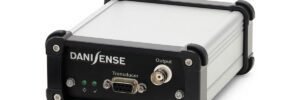
Danisense has launched the DSSIU-1-V, a compact single-channel power supply and interface unit designed for use with its high-precision flux gate direct current current transducers (DCCTs). Targeted at EV test benches, power analysis systems and current calibration setups, the unit simplifies signal readout and system integration for high-accuracy current measurements. The DSSIU-1-V features an integrated voltage output module that converts transducer signals into 1 V or 10 V outputs via a BNC connector. It uses an industry-standard D-sub-9 interface and provides a ±15 V DC, 1.2 A supply, powered from a universal 110–220 V AC input. With dimensions of 130 × 116 × 56 mm, it is designed for applications requiring a compact, standalone solution for powering and interfacing a single transducer. According to the company, the unit supports both flux gate and Hall effect transducers and is optimized for low-noise operation. “By offering such a voltage conversion, Danisense is simplifying the measuring chain by enabling its customers to have a direct connection of the transducer to instruments like an oscilloscope,” said Loic Moreau, Sales & Marketing Director at Danisense. The DSSIU-1-V is aimed at precision current sensing in demanding environments, particularly in EV development where accurate, stable measurements are required across a wide current range. Source: Danisense
Survey shows gap between AI expectations and results in engineering
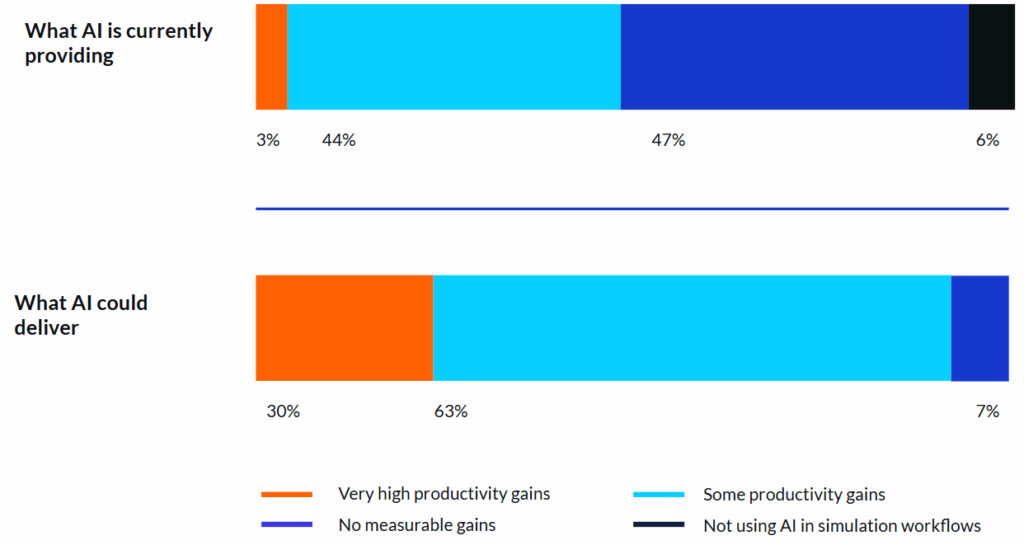
A new global survey of engineering leaders finds that although most anticipate productivity improvements from AI in design and simulation workflows, only 3% currently report significant gains—indicating a gap between expectations and current outcomes. The State of Engineering AI 2025 report, published today by SimScale in partnership with Global Surveyz, surveyed 300 senior engineering leaders from large enterprises (1,000+ employees) across the US and Europe. It offers an early benchmark of AI adoption in engineering, identifying cultural, process, and technical challenges that still need to be addressed. Figure 1: The productivity gains “Expectation-Execution Gap” seen with Engineering AI Key findings: AI ambition far outpaces execution:93% of engineering leaders expect AI to deliver productivity gains, with 30% anticipating very high gains. But just 3% report achieving that level of impact today. (see figure 1) Cloud-native adopters pulling ahead:Organizations using cloud-native simulation tools are 3x more likely to have mature AI programs and 6x more likely to have clean, centralized data—critical for scaling AI. They are also twice as confident in achieving AI goals within the next 12 months. Siloed data and legacy tools remain top barriers:55% cite siloed data and 42% cite legacy desktop CAE tools as major blockers—highlighting a foundational infrastructure gap across many organizations. Leadership misalignment is slowing progress:42% of CTOs cited resistance to AI adoption within technical teams—but engineer team leaders themselves report resistance just 29% of the time, suggesting technical teams are more open, ready, and motivated to adopt AI than leadership assumes. AI is seen as a growth driver, not just an efficiency play:Engineering leaders expect AI to fuel greater design innovation (54%), engineering productivity (51%), and faster time to market (47%)—with reduced costs ranking lowest on the list of expected benefits. The “3% Club”: What the most progressive teams do differently Despite the gap between expectations and outcomes, a small group of engineering leaders—the “3% club”—are already achieving measurable results with Engineering AI, driven by effective implementation rather than additional AI concepts. They share four key traits: Modernized Engineering Architecture: They’ve eliminated siloed, desktop-era toolchains in favor of cloud-native platforms. Their engineering data is centralized, accessible, and structured — using open formats and APIs. Integrated Agentic Workflows: These teams are building and integrating AI agents directly into live workflows — not as bolt-on tools, but as embedded decision-makers at setup, evaluation, and optimization stages. Fast Path from Prototype to Loop: They test in low-risk settings, but move quickly to real-world, in-the-loop deployment — proving value in weeks, not years. Treat Data & Models as Infrastructure: They log and version everything — from simulations to models — enabling AI to be scaled, trusted, and portable across their tools and processes. About the Research The State of Engineering AI 2025 is based on an independent survey conducted by Global Surveyz in June 2025, covering 300 senior engineering leaders across the US, UK, and Germany, and across six core industries: industrial machinery, automotive, electronics, life sciences, energy, and AEC. The full report is available to download at: simscale.com/state-of-engineering-ai The post Survey shows gap between AI expectations and results in engineering appeared first on Engineering.com.
Republicans keep wasting money: they want to scrap USPS’ new EVs (updated)
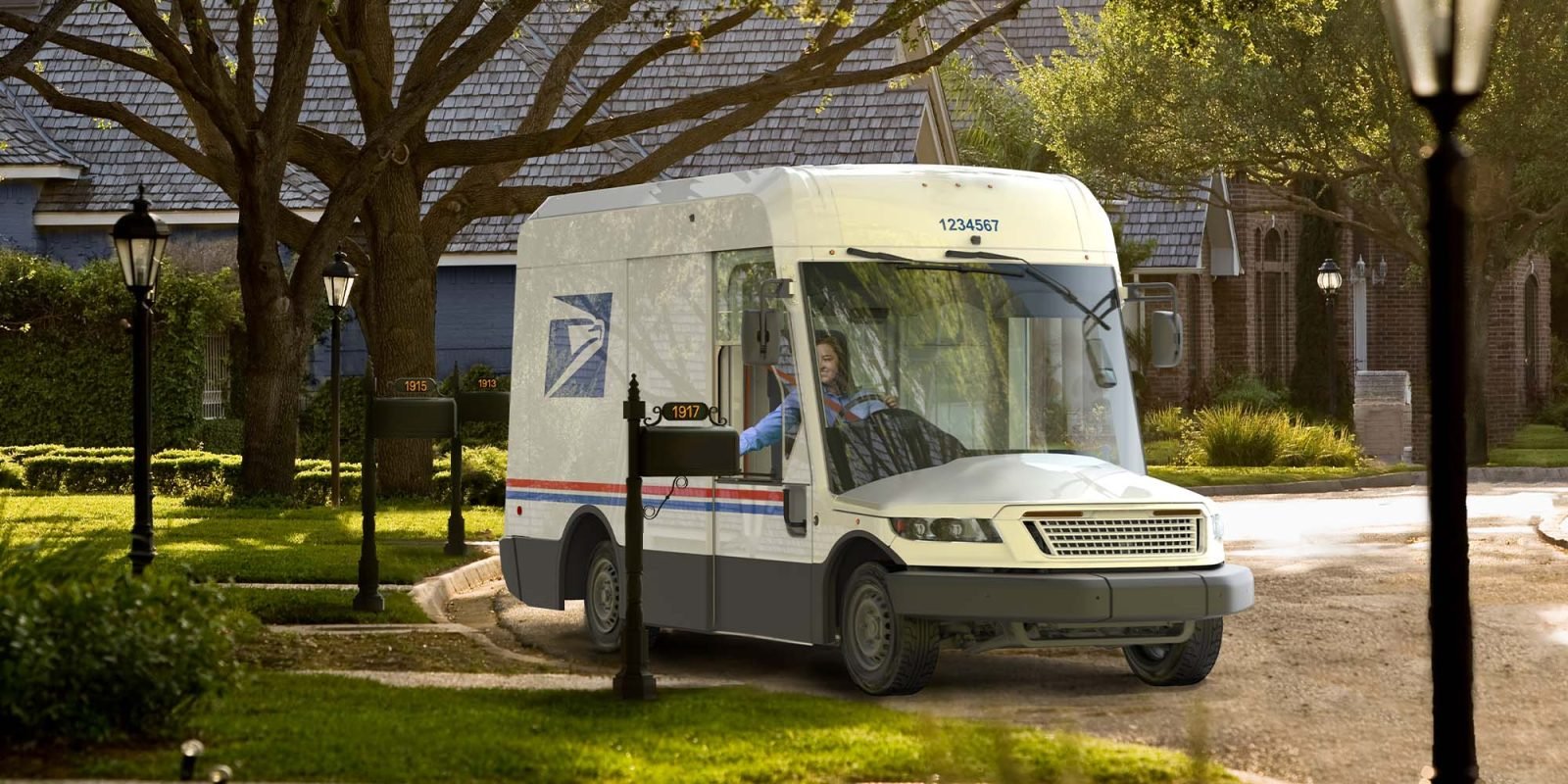
The Senate version of the repubilcans’ tax bill won’t just add trillions of dollars to the deficit through a massive giveaway to wealthy elites, it will also take the US Postal Service’s awesome new EVs and sell them off for pennies on the dollar, wasting money simply out of spite for vehicles that were already cleaning your air and making your community safer. Update: The Senate parliamentarian has ruled that the body can’t force USPS to scrap these EVs, at least not without a 60-vote supermajority. more…
WattEV breaks ground on heavy-duty electric truck charging depot at Port of Oakland

Heavy-duty EV charging provider WattEV has broken ground on its sixth heavy-duty electric truck charging depot in California, located at the Port of Oakland. The company currently operates five truck charging depots in California, and has another 15 sites under development. The addition of the new charging depot will establish a zero-emission freight corridor from the Bay Area to Sacramento, Nevada and beyond. WattEV’s public charging depot will be capable of charging 25 medium- and heavy-duty electric trucks concurrently at up to 240 kW each or six trucks at 1.2 MW. The depot is designed for megawatt charging, which can reduce charging dwell times to 30 minutes or less, comparable to diesel refueling times. “We’ve been working towards opening a Northern California charging depot for several years,” said Salim Youssefzadeh, CEO and co-founder of WattEV. “Until now, most truck charging infrastructure has been concentrated in Southern California. This project marks a significant milestone for WattEV, [enabling] zero-emission freight transport from key ports like Oakland and Stockton into Sacramento and Nevada.” Source: WattEV
BOXX Technologies launches new Creativ PCs for creators
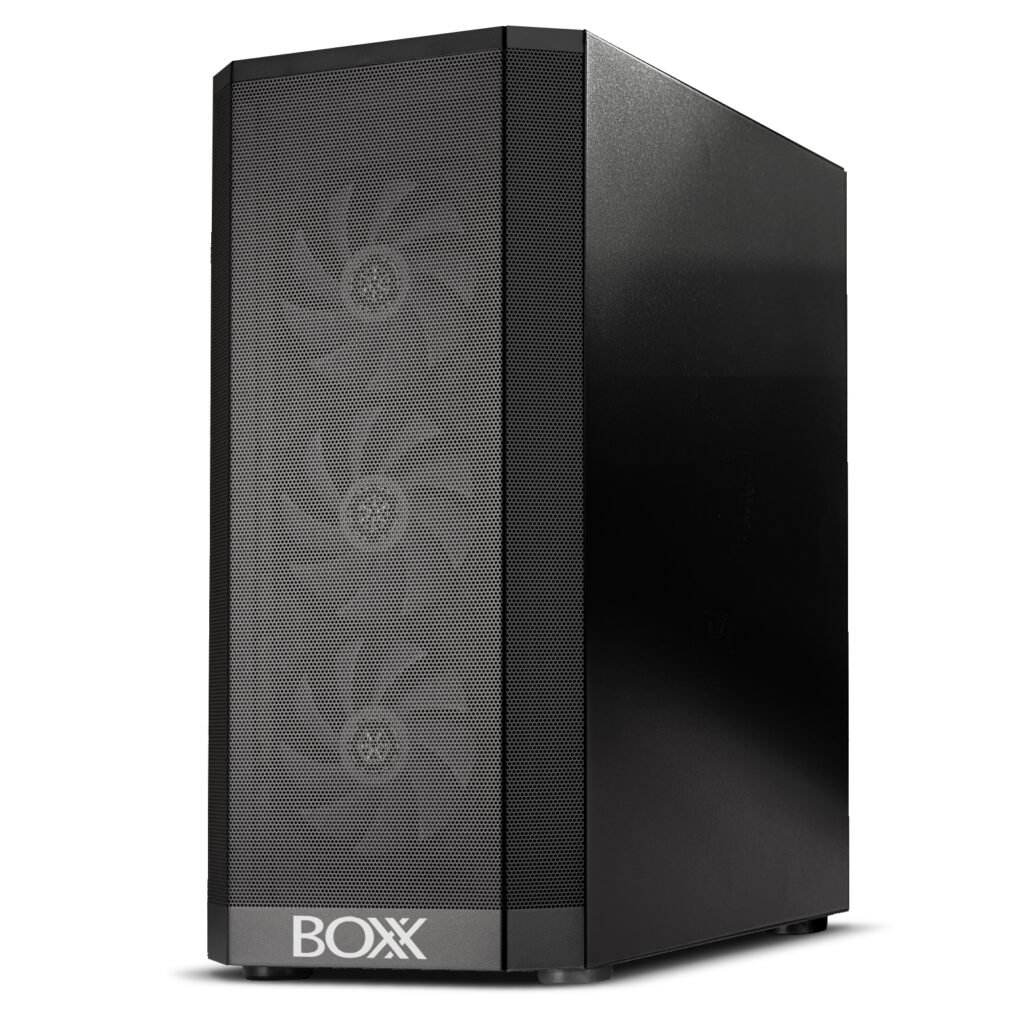
BOXX Technologies announced the launch of Creativ PCs, a new line of Creator PCs designed to support demanding creative workflows. The release expands BOXX’s product portfolio and reflects its continued focus on professional computing solutions. BOXX redefines creative power with launch of Creativ PCs Creativ PCs are designed to reduce performance bottlenecks and are optimized for professionals in architecture, media and entertainment, manufacturing engineering (CAD users), and other creative fields using applications such as SOLIDWORKS and Adobe Creative Cloud. The systems aim to deliver improved speed, stability, and responsiveness to support complex workflows. Creativ PCs features the latest high-performance components, selected and integrated by BOXX engineers for compatibility and stability. The system supports efficient rendering, smooth simulations, and responsive handling of complex datasets and high-resolution media. Key features and benefits of Creativ PCs include: Unrivaled Performance: Engineered for peak performance in multi-threaded and single-threaded applications. Optimized for Creative Software: Rigorously tested and tuned for leading applications like Autodesk Maya, V-Ray, Blender, and the Adobe Creative Cloud suite. BOXX Reliability: Backed by BOXX’s renowned engineering and expert technical support. Future-Ready Design: Configurable with the latest processors, professional graphics cards, and high-speed storage solutions. For more information, visit boxx.com. The post BOXX Technologies launches new Creativ PCs for creators appeared first on Engineering.com.
Early Prime Day Sales with up to 65% savings from Jackery + Anker SOLIX, EcoFlow dual expansion batteries $2,899 off, more

Today’s Green Deals are jam-packed with power station savings, led by Jackery’s early Prime Day Sale that is taking up to 65% off power stations with some extra ways to save too. Among the lineup, we spotted the brand’s Explorer 2000 Plus Solar Generator Bundle with two 200W panels down at $1,709. Right behind it we have the first round of Anker’s SOLIX early Prime Day flash sales, with options like the C300 AC 90,000mAh Power Station getting a 100W solar panel at a new $369 low, among larger units. Next, there’s EcoFlow’s first early Prime Day flash sale that has two DELTA Pro Smart Extra Batteries together at $2,699, as well as a WAVE 3 portable AC/heater bundle too. Among our electric lawn care solutions today is the Greenworks 40V 17-inch Cordless Push Lawn Mower at a new $230 low, as well as Worx’s Nitro 40V 15-inch Cordless String Trimmer with Dual-Exit Bump Feed Head, two 4.0Ah batteries, and a dual-port charger at its $190 low. Plus, there’s all the rest of the hangover Green Deals in the links at the bottom of the page, like yesterday’s full EcoFlow early Prime Day Sale lineup, Lectric’s 4th of July e-bike sale, and more. Head below for other New Green Deals we’ve found today and, of course, Electrek’s best EV buying and leasing deals. Also, check out the new Electrek Tesla Shop for the best deals on Tesla accessories. more…
Develon electrifies excavator lineup
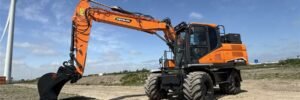
Construction equipment manufacturer Develon, previously known as Doosan Construction Equipment, has launched a new range of electric excavators. The first electric excavator—which carries the designation DX160WE-7—is a wheeled excavator. The DX160WE-7 and two crawler excavators based on the DX225LC-7 platform will be available with various battery configurations, including an extended range pack that should allow the excavator to operate for a full working day on a single charge. The new line is aimed at “supporting the transition to cleaner, quieter and more sustainable construction,” the company said. To develop electric drivetrains for this new line, the company partnered with ETEC Zero Emissions. The Waddinxveen, Netherlands-based company was founded as Elm in the 1930s. It had been a Doosan dealer for several decades and is continuing an even closer partnership with Develon post-name-change. ETEC was responsible for the integration of an electric drivetrain into several current Develon models to ensure the same performance as an ICE engine, albeit with zero emissions. While Develon was formerly known as Doosan Infracore, and Bobcat was part of the Doosan Group, the two companies are now separate entities under HD Hyundai. Source: Develon
Watch the first true Tesla Robotaxi intervention by safety monitor

Nearly 60 hours into the launch of the Tesla Robotaxi platform, it appears we have our first true intervention that required the in-car safety monitor to intervene. We’ve seen and heard about a handful of minor issues with the Robotaxi fleet thus far, one of which included a risky, but very human-like behavior of navigating across yellow lines to a turn lane after missing a turn. While that is not necessarily a legal maneuver, it is something that you’d see commonly from human drivers, and although aggressive, it is sometimes reasonable to perform depending on traffic conditions. For what it’s worth, the car seemed very confused by the situation, and while the safety monitor did not get involved and the car handled the situation with no real issue, it is something as a rider you’d like to see less of. First Look at Tesla’s Robotaxi App: features, design, and more As previously stated, that specific example did not require any intervention by a safety monitor. On Tuesday, we saw a video of the first true intervention that required the safety monitor who sits in the passenger seat to intervene by pressing a button on the center touchscreen. During a ride that Tesla investor and YouTuber Dave Lee was taking in Austin in a Robotaxi, the vehicle seemed to get a little confused by a UPS truck that was parallel parking in front of it. The monitor pressed the “Stop in Lane” button on the touchscreen: This is the first intervention we’ve seen with Robotaxi (via @heydave7): pic.twitter.com/B9ji3iLa3a — TESLARATI (@Teslarati) June 24, 2025 This appears to be one of the first errors shared by Tesla Robotaxi Early Access Program users that required the monitor to actually intervene. We have not seen any of it yet. You could also see the UPS truck is also a bit at fault here, as the space it pulled into did not seem even remotely large enough to fit the entire vehicle. The car may not have anticipated that the truck would park there. You can see how the UPS truck was parked below, and it seems reasonable that the Tesla might not have thought it would attempt to fit there: Credit: Dave Lee The Model Y’s steering wheel was also turning sharply right into this spot, it appears. Dave ended his ride here, and stated that this was his dropoff spot. The UPS truck might have just cut off the Tesla, which led to the intervention. It is a testament to Tesla’s strategy with this Robotaxi rollout. The company is obviously confident enough in the Full Self-Driving suite that it does not feel a human needs to be in the driver’s seat. However, it is still requiring someone, as of now, to sit in the passenger’s seat for instances just like this one. Safety is the company’s priority with the launch of Robotaxi, and CEO Elon Musk has reiterated that. It is expected that we’d eventually see some kind of intervention that requires a monitor to step in. Everyone was safe. Obviously, these things happen with autonomous vehicles. We’ve seen Waymos get stuck at intersections in very strange scenarios at times: Waymo turned into oncoming traffic on the way to work. It sat there confused for 45 seconds with its hazards on. Then it proceeded to back up into oncoming traffic. And they’re about to let these guys on the freeway pic.twitter.com/ZLRKx2loo1 — Jake Glaser | LA Multifamily (@LAMultiBroker) January 31, 2025 It is proof that autonomous tech is still in a growth phase and engineers are still learning about its capabilities. Tesla and other companies will learn from these rare cases and become better companies, and offer safer technologies because of it. The post Watch the first true Tesla Robotaxi intervention by safety monitor appeared first on TESLARATI.
Technological complexity needs systems engineers to lead the way into the future

Purdue University has sponsored this post. Image: Purdue. Technology has been advancing rapidly for the last few decades, and especially over the last five to ten years. In particular, the integrated systems that are enabled by technology are evolving at warp-speed, with increasing material, project and integration complexity. In order to meet the needs of our society and its dependence on current and future products, technologies, and services, we need more engineers who are able to support the development and sustainment of these technologies and their systems. “Engineering as a discipline is growing, and has been growing,” says Patrick Brunese, assistant head of the Edwardson School of Industrial Engineering at Purdue University. “There were calls during the Obama administration for rapidly scaling up the number of engineering graduates in the U.S. and abroad. Purdue attempted to meet that goal head-on by rapidly growing our engineering programs at the bachelor’s, master’s and doctoral levels, over the last decade. And that trend is continuing.” When it comes to systems engineering in particular, the last several years have seen substantial growth, in the realm of 10%, which is expected to continue over the next decade. While 10% growth may not necessarily seem like a large number, the reality is that from 2022 to 2023 there were around 80,000 to 90,000 unique job postings for systems engineers. “That’s a lot of new opportunities, or opportunities created by promotion and turnover of existing engineers,” Brunese says. For engineers who want to take advantage of these opportunities, whether they are currently in a systems role looking to upskill, wanting to move into a systems role for the first time, or seeking promotion and higher salary, a master’s degree in systems engineering is essential. Purdue offers a unique educational opportunity through its new, fully-online master’s of science in systems engineering. Offering the program online, rather than only as a residential experience, is because many engineers seeking a master’s degree are already employed, often as some other type of engineer. When they have the opportunity to move into a more formal systems engineering role, or are in a systems engineering role for their organization and looking to upskill, a flexible online option is what they need. Building the master’s in systems engineering When asked how Purdue decided to create the new program, “the simplest answer is, demand,” Burnese says. “We regularly communicate with different employers, many of whom come to Purdue every year through job fairs, research engagements, to recruit our students and interface with our faculty. They would often note the need for more direct education in systems engineering.” “And speaking as someone who has taught classes, we saw the same thing from the student side, saying ‘it would be really nice if there was a systems engineering program online,’” he adds. The discipline isn’t a new one for Purdue, which has been educating talented systems engineers for decades through the programs that already existed in the College of Engineering, such as industrial engineering, aeronautics or astronautics, mechanical, electrical and computer engineering. But an integrated educational program with the systems engineering title didn’t exist, even though the discipline has become increasingly vital to the engineering industry “Purdue has the Systems Collaboratory, which is a university-wide initiative for systems engineering education,” Burnese says. “It’s administratively led out of the Edwardson School of Industrial Engineering, but engages faculty from all over the university, in engineering and systems, and also social systems, technological systems, and the interface between these two things.” To design the systems engineering program, Purdue examined the organizations that help guide the discipline of systems engineering, such as the International Council on Systems Engineering, and the Institute of Industrial and Systems Engineers, to determine the core competencies and skill sets that systems engineers need. The curriculum was designed to bring together the coursework that would meet those needs, highlighting key components of systems engineering such as systems analysis and design, economics and decision-making, project management, systems tools and methodologies, and more. The program contains coursework from industrial, mechanical, electrical and computer engineering, as well as core systems engineering courses. This enables students to craft a program that meets their particular needs within their systems context, and makes the best use of Purdue’s interdisciplinary approach to systems engineering education. “The interdisciplinary curriculum gives our students the ability to emphasize the elements that matter to them, while ensuring they still get the core knowledge that is necessary to say we’ve educated students in a particular area,” says Burnese. Courses are primarily taught by Purdue faculty, and there is no difference in coursework or course expectations between residential students and online students. “They’re getting the same educational experience, the same content, same assessments, same faculty teaching the class, and the same access to the faculty when you want to engage deeply with a topic,” Burnese says. Students graduate with a broad set of systems skills, not just the hard classical systems engineering like model-based systems engineering and other tools. Purdue ensures graduates develop a soft systems perspective and approach, along with other types of breadth through elective courses that focus on a student’s primary area of interest. The depth and breadth of Purdue’s courses ensure that every student graduates with a deep understanding of systems engineering, and the latest up-to-date skills that their career and their industry needs. Flexibility is key for working engineers Flexibility is the name of the game when it comes to online education, and one of the primary benefits for engineers looking to complete a master’s program while working. With lectures and assignments delivered asynchronously, students can complete their coursework on a schedule that works with their job and personal schedules. Lectures are delivered live for residential students in classrooms featuring recording and video streaming equipment, and remote students can attend if their schedule allows. The recorded lecture video is then available online to watch on demand. “If there were not programs like this in the online space, you’d have to be located — or
QuantumScape has integrated its ‘Cobra’ process, reducing solid-state production time tenfold
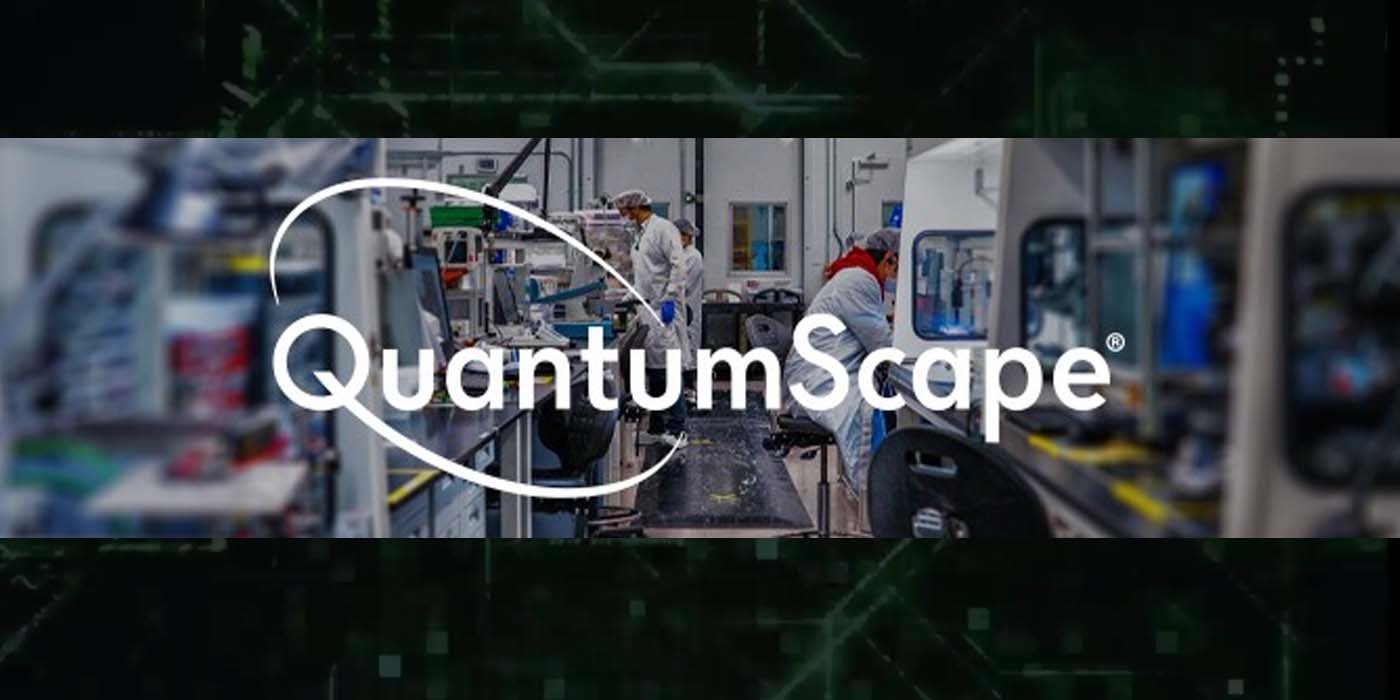
Solid-state battery developer QuantumScape shared another exciting milestone today: integrating its long-developed “Cobra” solid-state separator manufacturing process into its baseline production. This step technology significantly reduces the overall footprint and production time of QuantumScape’s proprietary solid-state cells, setting the stage for commercialized production. more…
Ford hopes to complete its Michigan LFP battery plant, even if Republicans nix tax break
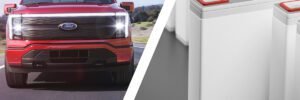
Legacy automakers know that EVs are the future—but as public companies, the only future they can plan for is next quarter’s earnings report. As the current US administration slashes support for new technologies, automakers have been mostly silent, and some have quietly scaled back previously-announced electrification plans. So, it’s refreshing to hear that Ford still hopes to complete a new LFP battery plant it’s building in Michigan, even if Congress makes the project ineligible for tax incentives. The $3-billion plant, in Marshall, Michigan, uses technology that Ford licensed from Chinese battery maker CATL. Tax credits for US battery plants provided under the Inflation Reduction Act could offset about a quarter of the cost of the plant, Ford execs said. However, a bill making its way through Congress would ban federal support for battery plants that use technology from China. Ford says losing the credits would have a “very material” effect on the plant’s financial performance. “We don’t want to back off on this facility,” Lisa Drake, VP of Ford’s Technology Platform Programs and EV Systems, told reporters. “It would really be a shame to build these facilities and then all of a sudden have to scale back on the most important part, which is people.” Ford’s plant is scheduled to start production in 2026 and is expected to create 1,700 jobs. Several other US battery plants under construction use technology from suppliers based in South Korea or Japan, which are not targeted by the bill. Ms. Drake said Ford probably would have built the plant outside the US if not for the tax credits provided by the Biden administration’s IRA. She also noted that manufacturing machinery for the plant, now in transit from China, will be subject to higher tariffs than previously expected. A White House spokesman told the New York Times: “Our autoworker community strongly supports the president’s agenda and stands with him every step of the way.” Well, maybe not all of the autoworker community. David Green, Director of the United Auto Workers region covering Ohio and Indiana, recently wrote in The Ohio Capital Journal: “Repealing clean vehicle tax credits alone could reduce EV sales as much as 40 percent by 2030, and could result in the idling of existing assembly plants and the cancellation of many planned EV battery manufacturing facilities. The irony is stark and painful: thousands of battery workers have just voted to unionize, ensuring their jobs are high-quality and family-supporting. Now congressional Republicans are voting to kill those very same jobs.” Sources: New York Times, Washington Examiner, Ford
Tesla Robotaxi launch draws attention from regulators, mainstream media milks it

Tesla launched its Robotaxi platform in a limited capacity earlier this week in Austin, Texas, and after hundreds of rides have been taken, some instances have caught the attention of the National Highway Traffic Safety Administration (NHTSA). However, the information the NHTSA is requesting is routine and totally normal for the early stages of a rollout of this magnitude. But that did not stop mainstream media from milking it into something controversial, when it really is not. Tesla Robotaxi riders tout ‘smooth’ experience in first reviews of driverless service launch Various outlets reported on the NHTSA’s request to Tesla for additional information regarding things seen in videos online. The NHTSA said it is “aware of the referenced incidents and is in contact with the manufacturer to gather additional information.” Bloomberg initially reported on the NHTSA’s request for information. The thing is, the NHTSA has often reached out to companies right after it launches a driverless vehicle service. Both Waymo and GM’s Cruise, as well as Amazon’s Zoox, have had the NHTSA reach out to them regarding the launch of their driverless ride-hailing services. The headlines for Tesla are significantly different: “Tesla’s Robotaxis Have Already Caught this US Safety Agency’s Attention“ “Tesla’s Robotaxis have already caught the attention of federal safety regulators“ “US safety regulators contact Tesla over erratic robotaxis“ Reviews from riders in Austin have stated the Robotaxi platform is “smooth” and “comfortable,” with many ranting and raving about the advantages the new ride-hailing service has over others. Not only is it being monitored by a safety monitor in the passenger seat, but there are also other things that make it unique. One of the most notable is that your Robotaxi will automatically sync entertainment and streaming settings. The sensationalism that the media tends to use with Tesla is a big reason the company did not invite mainstream outlets to the event. Instead, reporters were seen waiting for Early Access invitees to exit their cars to ask them questions. Many denied the inquiries: “Can I talk to you, I’m with Reuters” > No @BeardedTesla @SawyerMerritt pic.twitter.com/jGUdakGzx1 — Robin (@xdNiBoR) June 22, 2025 Elon Musk responded to that video by saying “Lmao,” an acronym for “laughing my ass off.” The post Tesla Robotaxi launch draws attention from regulators, mainstream media milks it appeared first on TESLARATI.
CAD to OpenUSD export gets easier

Welcome to Engineering Paper. Here’s the latest design and simulation software news. Tech Soft 3D and Nvidia announced a new collaboration to further the mission of OpenUSD, the Pixar-created 3D file framework underpinning Nvidia’s Omniverse platform. For starters, Tech Soft 3D has officially joined the Alliance for OpenUSD (AOUSD). It will now work alongside founding members Adobe, Apple, Autodesk, Nvidia and Pixar, plus all the other general members, to develop and champion the 3D standard. But the real boost for Universal Scene Description, to use the framework’s formal name, is in Tech Soft 3D’s latest release of HOOPS Exchange. The software development toolkit for CAD data translation now supports export to OpenUSD, which Tech Soft 3D says will allow developers to bring engineering data from over 30 CAD file formats, including Catia, STEP, Solidworks, and more, into any 3D application that supports OpenUSD. “Tech Soft 3D’s investment in USD is great news for the entire industrial and CAD ecosystem,” said Aaron Luk, director of product management at Nvidia, in Tech Soft 3D’s press release. (OpenUSD used to be called USD, but the name was changed when the Alliance for OpenUSD launched in 2023.) Luk continued: “HOOPS offers an unparalleled opportunity for CAD users to seamlessly connect their data to USD, unleashing the immense power of its composition capabilities to aggregate diverse data sources and construct comprehensive digital twins for industrial and physical AI use cases.” This is the first I’m hearing about the AI use cases for OpenUSD, but I’d be more surprised if Nvidia didn’t find a way to bring it up somehow. Siemens and Altair are enjoying their honeymoon Three months later, how’s Siemens’ $10 billion acquisition of Altair going? I’m glad you asked, because I sat down with Sam Mahalingam, CTO of Altair, and Jean-Claude Ercolanelli, SVP of simulation and test solutions at Siemens Digital Industries Software, to get answers. One surprising revelation: Altair, the brand, is going away. Turns out Siemens is serious about that ONE Tech Company thing. For more inside details, including how the simulation developers are using AI, check out Siemens and Altair are on a mission to “transform engineering.” Design and Simulation Week 2025 If you’re not already counting down the days to Engineering.com’s annual Design and Simulation Week, here’s your 20-day warning. Running the week of July 14, 2025, this series of expert webinars will explore the top trends in engineering software from some of the leading voices in the industry (and me). You’ll learn about AI, automation, multiphysics and how to make the most of modern tools. Register for Design and Simulation Week now and start counting. Quick hits IMSI Design has released TurboCAD Mac 16, the latest version of its 2D and 3D CAD platform for macOS. It’s available as a perpetual license in four tiers: Platinum, Pro, Deluxe, and Designer, in descending order of price and functionality. Kubotek Kosmos has released KeyCreator 2025 Service Pack 2, which includes updated CAD file format translators and minor enhancements such as more text formatting options. Hexagon is preparing to spin off several of its divisions into a standalone company called Octave. It would include Hexagon’s existing Asset Lifecycle Intelligence and Safety, Infrastructure and Geospatial divisions, plus ETQ (currently operating under the Manufacturing Intelligence division), and Bricsys (currently operating under the Geosystems division and developer of the BricsCAD platform). The spinoff remains subject to shareholder, Board, and regulatory approvals. Siemens Digital Industries Software is showing off new AI tools for electronic design automation (EDA) at the 2025 Design Automation Conference this week in San Francisco. The company says it’s developed “a new EDA AI system specifically designed for semiconductor and PCB design environments” that “delivers secure, advanced generative and agentic AI capabilities, offering unparalleled customization capabilities and seamless integration across the entire EDA workflow.” One last link Michelle Froese of EV Engineering & Infrastructure explains Why EV architecture changes the rules for self-driving systems. Got news, tips, comments, or complaints? Send them my way: malba@wtwhmedia.com. The post CAD to OpenUSD export gets easier appeared first on Engineering.com.
ONYX launches new 65 MPH electric moped, boosting power even higher

ONYX Motors has just announced the second version of its storied RCR electric moped launched since the brand’s revival late last year. The new ONYX RCR 80V pushes the bike to its highest performance yet, breaking new power and speed records for the company while simultaneously raising questions about how to properly classify these fast electric motorbikes with pedals – and just who they’re for. more…
comemso introduces SmartCal for automated calibration of EV battery cell simulators
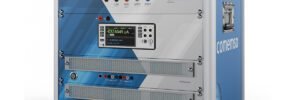
comemso has announced SmartCal, a fully automated calibration system for its Battery Cell Simulator (BCS), targeting developers and testers of battery management systems (BMS) in electric vehicle and high-voltage test environments. The SmartCal system enables on-site or in-lab calibration and adjustment of BCS units, designed to maintain long-term measurement accuracy in EV battery testing. SmartCal integrates an automated process and user interface with a 6.5-digit digital multimeter calibrated to ISO 17025 standards. For in-house use, calibration and measurement data are stored in a centralized comemso database. When used at the customer’s facility, the data is saved locally and automatically exported as a PDF calibration report. The system supports both verification and channel adjustment functions, allowing precise tuning of individual simulator channels. It can be rented or purchased and deployed flexibly across laboratory and production environments. comemso says the system helps ensure consistent measurement quality while eliminating downtime caused by device returns. “If you want to develop good BMS, you have to be able to test them precisely,” said Dr. Kiriakos Athanasas, CEO of comemso. “With SmartCal, we ensure that our customers can maintain the high measurement quality of their BCS over many years—simply, automatically and precisely.” SmartCal is designed for use in EV development, BMS end-of-line test systems, and energy storage applications. By enabling decentralized calibration, the system reduces logistical effort and minimizes testing interruptions. Source: comemso
IRA tax credit uncertainty kills $1.4 billion in clean energy projects in May

As the Senate continues to debate the fate of the clean energy tax credits established within the Inflation Reduction Act (IRA), the clean energy marketplace continues to take a financial hit. The latest report from E2 and the Clean Energy Buyers Alliance (CEBA) found that $1.4 billion of clean energy projects and factories were canceled in May. Impacting states including West Virginia, Alabama and Arizona, these numbers were actually an improvement over the loss off projects in April, which saw a $4.5 billion loss. “The consequences of continued policy uncertainty and the expectation of higher taxes on clean energy businesses are becoming painfully clear,” said Michael Timberlake, E2 communications director, “With renewable energy supplying more than 90 percent of new electricity in America last year, canceled projects will likely mean less available energy and higher electricity prices for consumers and business alike.” Since the Trump administration came into office, $15.5 billion in new factories and electricity projects have been cancelled, along with roughly 12,000 potential jobs. Eight clean technology projects were cancelled in May 2025. Graphic courtesy of E2. Despite these setbacks, the clean technology sector continues to grow, albeit at a much slower pace: $450 million of investments in solar, EV and grid and transmission factories and projects was announced in May. Rivian, for example, announced a $120 million investment to build a 1.2 million square foot supplier park in Illinois. The post IRA tax credit uncertainty kills $1.4 billion in clean energy projects in May appeared first on Trellis.

